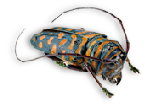





2014

2003


1999
2002

Institut de Recherche sur la Biologie de l'Insecte
UMR 7261 Faculté des Sciences et Techniques
Avenue Monge, Parc Grandmont
37200 TOURS (France)


2013

Below are listed the publications (in journals and book chapters) that result from the research conducted in the Casas Group. The work done by the members while outside the group (past postdoc etc), and published, can be obtained from the own personal page of these people.
PDFs can be downloaded freely for most articles.
Defrize, J., Llandres, A.L. & Casas, J. (2014) Indirect cues in selecting a hunting
site in a sit-
Steinmann, T. & J. Casas (2014). Laser-
Krijnen,G.J.M., Droogendijk, H., Dagamesh, A.M.K., Jaganatharaja, R.K. & J. Casas
(2014). Crickets as bio-
Anita, S., J. Casas & C. Suppo (2013). Impulsive spatial control of pests by generalist predators, in revision to Mathematical Medicine & Biology.
Bimbard, G., Kolomenskiy,D., Casas, J. and R. Godoy-
Llandres, A.L., Figon, F., Christides, J.P., Mandon, N. & Casas, J. (2013) Environmental
and hormonal factors controlling reversible colour change in crab spiders. Journal
of Experimental Biology 216: 3886-
Morice, S., Kaiser, W., Pincebourde, S., Darboux, F. & J. Casas (2013). Pursuit-
Voise, J. & J. Casas (2013). Use of water wave propagation for echolocation in whirligig beetles: an unsubstantiated conjecture. In Vibrational communication, R. Cocroft, Wessel, A. & M. Gogala (eds). Springer Verlag.
Steinmann, T. & J. Casas (2013). Laser-
Saudreau M., Pincebourde S., Dassot M., Adam B., Loxdale H. D. and Biron D. G. (2013).
On the canopy structure manipulation to buffer climate change effects on insect herbivore
development. Trees -
Casas, J., Liu, C., & Krijnen, G. (2013). Biomimetic Flow Sensors. Encyclopedia Nanotechnology 2013, 264–276.
Pincebourde S., Sanford E. and Helmuth B. (2013). Survival and arm abscission are linked to regional heterothermy in an intertidal sea star. The Journal of Experimental Biology, in press.
Potter k., Woods A. and Pincebourde S. Microclimate challenges in global change biology. In revision for Global Change Biology.











2012
Richard, R., Casas, J. (2012), A quantitative framework for ovarian dynamics. Functional
Ecology, 26: 1399–1408. doi: 10.1111/j.1365-
Krijnen, G., Droogendijk, H., & Dagamseh, A. Jaganatharasha R., Casas J. (2012) Crickets
as bio-
Insausti, T. C., Defrize, J., Lazzari, C. R., & Casas, J. (2012). Visual fields and
eye morphology support color vision in a color-
Casas, J., & McCauley, E. (2012). Daily foraging cycles create overlapping time-
Pincebourde, S., Sanford, E., Casas, J., & Helmuth, B. (2012). Temporal coincidence
of environmental stress events modulates predation rates. Ecology letters, 15(7),
680–8. doi:10.1111/j.1461-
Pincebourde, S. and Woods, A. H. (2012). Climate uncertainty on leaf surfaces: the
biophysics of leaf microclimates and their consequences for leaf-
Casas J, (2012) Le Biomimétisme : convergence de disciplines. (n.d.).
Giron, D, Dicke, M., .Pieterse J., M, & Frago, E. (2012). Cytokinins as key regulators
in plant–microbe–insect interactions: connecting plant growth and defence €. doi:10.1111/1365-
Moiroux, J., Giron, D., Vernon, P., van Baaren, J., & van Alphen, J. J. M. (2012). Evolution of metabolic rate in a parasitic wasp: the role of limitation in intrinsic resources. Journal of insect physiology, 58(7), 979–84. doi:10.1016/j.jinsphys.2012.04.018
Foray V, Pelisson P-
Robert C, Veyrat N, Glauser G, Marti G, Doyen GR, Villard N, Gaillard MDP, Köllner
TG, Giron D, Body M, Babst BA, Ferrieri RA, Turlings TCJ & Erb M.(2012) A specialist
root herbivore exploits defensive metabolites to locate nutritious tissues.Ecology
Letters 15 (1), 55-
Dupuy, F., Steinmann, T., Pierre, D., Christidès, J.-
Morley, E. L., Steinmann, T., Casas, J., & Robert, D. (2012). Directional cues in
Drosophila melanogaster audition: structure of acoustic flow and inter-












2011

2010
Brice Bathellier, Thomas Steinmann, Friedrich G. Barth and Jérôme Casas (2011) Air
motion sensing hairs of arthropods detect high frequencies at near-
Rolf Brechbuhl, Jerome Casas, Sven Bacher (2011) Diet choice of a predator in the
wild: overabundance of prey and missed opportunities along the prey capture sequence.
Ecosphere 2(12):133 doi:10.1890/ES11-
Jonathan Voise, Michael Schindler, Jérôme Casas and Elie Raphaël (2011) Capillary-
Cannesan M, Gangneux C, Lanoue A, Giron D, Laval K, Hawes M, Driouich A & Vicré-
Steve Alpern, Robbert Fokkink, Marco Timmer and Jérôme Casas. (2011) Ambush frequency should increase over time during optimal predator search for prey J. R. Soc. Interface (online)
T.C. Insausti, C.R. Lazzari, J. Casas (2011) The morphology and fine structure of
the giant interneurons of the wood cricket Nemobius sylvestris. Tissue&Cell 43-
Fabienne Dupuy, Jérôme Casas, Mélanie Body, Claudio R. Lazzari (2011) Danger detection
and escape behaviour in wood crickets Journal of insect physiology 57, 865-
Marc Théry, Teresita C. Insausti, Jérémy Defrize and Jérôme Casas. (2011) The multiple disguises of spiders Book
Jérémy Defrize, Claudio R. Lazzari, Eric Warrant, Jérôme Casas. (2011) Spectral sensitivity of a colour changing spider. Journal of insect Physiology (online)
Giron D. & Huguet E. (2011). A genomically tractable and ecologically relevant model
herbivore for a model plant: new insights on mechanisms of insect-

2009









Casas J. and Simpson S.J. 2010. Increasing Demands and Vanishing Expertise in Insect
Integrative Biology. In Jérôme Casas and Stephen J. Simpson, editors. Advances in
Insect Physiology, Vol. 38. Burlington: Academic Press, pp. 1-
Randlkofer B., Obermaier E., Casas J. and Meiners T. 2010. Connectivity counts: disentangling
effects of vegetation structure elements on the searching movement of a parasitoid.
Ecological Entomology, DOI: 10.1111/j.1365-
Kaiser W., Huguet E., Casas J., Commin C. & Giron D. (2010) Plant green-
Casas J, Steinmann T and Krijnen G (2010) Why do insects have such a high density
of flow-
Casas J. Dangles 0. (2010). Physical Ecology of Fluid Flow Sensing in Arthropods.
Annual review Entomology, 55, 505-
Voise J. & Casas J. (2010). The management of fluid and wave resistances by whirligig
beetles, J. R. Soc. Interface, 7, 343-
Brechbühl R., Casas J. and Bacher S. (2010) Ineffective crypsis in a crab spider:
a prey community perspective Proc. R. Soc. B, 277, 739-
Carita Lindstedt, Nathan Morehouse, Hannu Pakkanen, Jérôme Casas, Jean-
Emmanuel Desouhant • Patrice Lucchetta David Giron • Carlos Bernstein (2010) Feeding
activity pattern in a parasitic wasp when foraging in the field. Ecological Research
DOI 10.1007/s11284-










2008
Insausti T.C., Casas J. (2009). Turnover of pigment granules: Cyclic catabolism and anabolism of ommochromes within epidermal cells. Tissue Cell, doi: 10.1016/j.tice.2009.05.002
Dupuy F., Casas J., Bagnères A.G., Lazzari C.R. (2009). OpenFluo: A free open-
Richard R. & J. Casas (2009), Stochasticity and controllability of nutrient sources
in foraging: host-
Dangles O., D. Irschick, L. Chittka & J. Casas (2009, invited review). Variability
in sensory ecology: contributions of niche, ontogeny and phylogeny. Quarterly Review
of Biology, 84:51-
Casas, J., Vannier F., Mandon N., Delbecque JP., Giron D. & Monge JP. (2009). Mitigation
of egg limitation in parasitoids: immediate hormonal response and enhanced oogenesis
after host use. Ecology, 90:537-
Théry, M. & J. Casas (2009). The multiple disguises of spiders: web colour and decorations,
body colour and movement. Philosophical Transactions Royal Society B, 364:471-
Sinoquet, H., S. Pincebourde, B. Adam, N. Donès, J. Phattaralerphong, D. Combes,
S. Ploquin, K. Sangsing, P. Kasemsap, S. Thanisawanyangkura, G. Groussier-
Curculio nucum. Bel-

2007
Dangles, O., T. Steinmann, D. Pierre, F. Vannier & J. Casas (2008). Relative contribution of organ shape and receptor arrangement on the design of cricket's cercal system. Journal of Comparative Physiology A, in press.
Insausti, T., C. Lazzari & J. Casas (2008). The terminal abdominal ganglion of the wood cricket Nemobius sylvestris. Journal of Morphology, in press. DOI: 10.1002/jmor.10672.
Casas, J., T. Steinmann & O. Dangles (2008). The aerodynamics signature of running spiders. PLoS One 3(5): e2116. doi:10.1371/journal.pone.0002116
Insausti, T. & J. Casas (2008). The functional morphology of color changing in a
spider: development of ommochromes pigment granules. Journal of Experimental Biology,
211: 780-
Magal, C. & Cosner, C., Ruan, S., J. Casas (2008). Control of invasive hosts by
generalist parasitoids. Mathematical Medicine & Biology, 25: 1-

2006

2005
Fertin, A. & J. Casas (2007). Orientation towards prey in antlions: efficient use
of wave propagation in sand. Journal of Experimental Biology, 210: 3337-
Dangles, O., D. Pierre, JP. Christides & J. Casas. (2007). Escape performance decreases
during ontogeny in wild crickets. Journal of Experimental Biology, 210: 3165-
Giron, D., W. Kaiser, N. Imbault & J. Casas (2007). Cytokinin-
Pincebourde, S., H. Sinoquet, D. Combes & J. Casas (2007). Regional climate modulates
the canopy mosaic of favourable and risky microclimates for insects. Journal of Animal
Ecology, 76: 424-
Strand, M. & J. Casas (2007). Parasitoid and Host Nutritional Physiology in Behavioural Ecology, in Behavioral Ecology of insect parasitoids, E. Wajnberg, C. Bernstein & J. van Alphen (eds) . Blackwell, London.
Heimpel, G. & J. Casas (2007). Parasitoid foraging and oviposition behaviour in the field, in Behavioral Ecology of insect parasitoids, E. Wajnberg, C. Bernstein & J. van Alphen (eds) . Blackwell, London.
Casas, J., C. Magal & J. Sueur (2007). Dispersive and non-
Giron D, Ross KG & Strand MR (2007) Presence of soldier larvae determines the outcome
of competition in a polyembryonic wasp. Journal of Evolutionary Biology 20 (1),
165-
Giron D, Harvey JA, Johnson JA, Strand MR. (2007) Male soldier caste larvae are non-
Dangles, O., D. Pierre, F. Vannier & J. Casas (2006). Ontogeny of air-
Steinmann, T., J. Casas, G. Krijnen & O. Dangles (2006). Air-
Pincebourde, S., E. Frak, H. Sinoquet, JL. Regnard & J. Casas (2006). Herbivory mitigation
through increased water-
Fertin, A. & J. Casas (2006). Efficiency of antlion trap construction. Journal of
Experimental Biology, 209: 3510-
Magal, C., O. Dangles, P. Caparroy & J. Casas (2006). Hair canopy of cricket sensory
system tuned to predator signals. Journal of Theoretical Biology, 241: 459-
Dangles, O., N. Ory, T. Steinmann, JP. Christides & J. Casas (2006). Spider attacks
vs cricket's escape: velocity modes determine success. Animal Behavior, 72: 603-
Pincebourde, S. & J. Casas (2006). Multitrophic biophysical budgets: thermal ecology
of an intimate herbivore insect-
Dangles, O., J. Casas & I. Coolen (2006). Textbook cricket goes to the field: the
ecological scene of the neuroethological play. Journal of Experimental Biology, 209:
393-
Pincebourde, S. & J. Casas (2006). Leafminer induced changes in leaf transmittance
cause variations in insect respiration rates. Journal of Insect Physiology, 52:194-
Keasar T, Segoli M, Barak R, Steinberg S, Giron D, Strand MR, Bouskila A & Harari
AR. (2006) Costs and consequences of superparasitism in the polyembryonic parasitoid
Copidosoma koehleri (Hymenoptera: Encyrtidae). Ecological Entomology 31 (3), 277-

2004
Coolen, I., O. Dangles & J. Casas (2005). Social learning in non-
Venner, S. & J. Casas (2005). Spider webs designed for rare but lifesaving catches.
Proceedings Royal Soc. B., 272: 1587-
Casas, J. & C. Magal (2005). Vibratory communication in host-
Dangles, O., C. Magal, D. Pierre, A. Olivier & J. Casas (2005). Variation in morphology
and performance of predator-
Casas, J., S. Pincebourde, N. Mandon, F. Vannier, R. Poujol & D. Giron (2005). Lifetime
nutrient dynamics reveal simultaneous capital and income breeding in a parasitoid.
Ecology, 86: 545-
van Loon, J., S. Pincebourde & J. Casas (2005). Nutritional ecology of insect plant-
Théry, M., M. Debut, D. Gomez & J. Casas (2005). Specific color sensitivities of
prey and predator explain simultaneous crab-
Giron, D., S. Pincebourde & J. Casas (2004). Lifetime gains of host-
Casas, J., S. Swarbrick & W. Murdoch (2004). Parasitoid behaviour: predicting field
from laboratory. Ecological Entomology, 29: 657-
Djemai, I., J. Casas & C. Magal (2004). Parasitoid foraging decisions mediated by
artificial vibrations. Animal Behavior, 67: 567-
Giron D & Strand MR. (2004) Host resistance and the evolution of kin recognition
in polyembryonic wasps. Proceedings of the Royal Society, London B 271, Suppl 6:S
395-
Giron D, Dunn DW, Hardy ICW & Strand MR. (2004) Aggression by polyembryonic wasp soldiers correlates with kinship but not resource competition.
Casas, J., G. Driessen, N. Mandon, S. Wielaard, E. Desouhant, J. van Alphen, L. Lapchin,
A. Rivero, J.P. Christides & C. Bernstein (2003). Strategies of energy acquisition
and use of a parasitoid foraging in the wild. Journal of Animal Ecology, 72: 691-
Turchin, P., S.N. Wood, S.P. Ellner, B.E. Kendall, W.W. Murdoch, A. Fischlin, J.
Casas, E. McCauley & C.J. Briggs (2003). Dynamical effects of plant quality and parasitism
on population cycles of larch budmoth . Ecology, 84: 1207-
Giron, D. & J. Casas (2003). Lipogenesis in adult parasitic wasps. Journal of Insect
Physiology, 49: 141-
Giron, D. & J. Casas (2003). Mother's investment decreases over time. Ecology Letters,
6: 273-
Giron, D., A. Rivero, N. Mandon, E. Darrouzet & J. Casas (2002). The physiology of
host-
Casas, J. & I. Djemai (2002). Plant canopy architecture and multitrophic interactions. In: T. Tscharnke & B. Hawkins (Eds). Multitrophic interactions . Cambridge University Press.
Théry, M. & J. Casas (2002). Predator and prey views on spider camouflage. Nature, 415: 133 & supplementary information on the web.







































2013

2001
Djemai, I., J. Casas & C. Magal (2001). Matching host reactions to parasitoid vibrations.
Proceedings Royal Society London, 268: 2403-
Tautz, J., J. Casas & D. Sandeman (2001). Phase reversal of vibratory signals in
honeycomb may assist dancing honeybees to attract their audience. Journal of Experimental
Biology, 204: 3737-
Rivero, A., D. Giron & J. Casas (2001). Lifetime allocation of juvenile and adult
nutritional resources to egg production in a holometabolous insect. Proceedings Royal
Society London, 268: 1231-

2000
Magal, C., M. Schöller, J. Tautz & J. Casas (2000). The role of leaf structure on
vibratory signal propagation. Journal of the Acoustical Society of America,108: 2412-
Djemai, I., R. Meyhöfer & J. Casas (2000). Geometrical games in a host-
Casas, J. (2000). Host location and selection in the Field. In: M. Hochberg & T. Ives (Eds). Parasitoids Population Biology . Princeton University Press.
Casas, J., R. Nisbet, S. Swarbrick & W.W. Murdoch (2000). Eggload dynamics and oviposition
rate in a wild population of a parasitic wasp. Journal of Animal Ecology, 69: 185-
Rivero, A. & J. Casas (1999). Rate of nutrient incorporation to egg production in
a parasitic wasp. Proceedings Royal Society London B, 266: 1169-
Rivero, A. & J. Casas (1999). Incorporating physiology into parasitoid ecology: the
allocation of nutritional resources. Invited review article in a special issue 'Parasitoids'
(eds. H.C.J. Godfray & M. Shimada) in Research on Population Ecology, 41: 39-
Meyhöfer, R. & J. Casas (1999). Vibratory stimuli in host location by parasitic wasps.
Journal of Insect Physiology, 45: 967-

1998
Casas, J., S. Bacher, J. Tautz, R. Meyhöfer & D. Pierre (1998). Leaf vibrations and
air movements in a leafminer-

Keywords :
Integrative biology
Organismal biology
Functional ecology
Quantitative ecology
Population dynamics
Community dynamics
Climate change biology
Nature inspired technology
Agroecology-Agroforestry
Biological invasions
Arthropod biology
Multitrophic interactions
Ecomechanics
Chemical ecology
Environmental genomics
